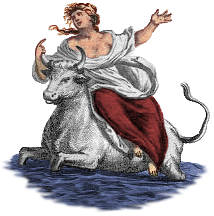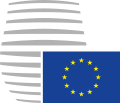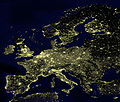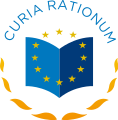
Back بوابة:الاتحاد الأوروبي Arabic Portal:Avropa İttifaqı Azerbaijani প্রবেশদ্বার:ইউরোপীয় ইউনিয়ন Bengali/Bangla Portal:Unió Europea Catalan Portál:Evropská unie Czech Portal:Den Europæiske Union Danish Portal:Europäische Union German Πύλη:Ευρωπαϊκή Ένωση Greek Portal:Unión Europea Spanish Teemasivu:Euroopan unioni Finnish
Introduction
The European Union (EU) is a supranational political and economic union of 27 member states that are located primarily in Europe. The Union has a total area of 4,233,255 km2 (1,634,469 sq mi) and an estimated total population of over 448 million. The EU has often been described as a sui generis political entity (without precedent or comparison) combining the characteristics of both a federation and a confederation. Containing 5.8% of the world population in 2020, EU member states generated a nominal gross domestic product (GDP) of around US$16.6 trillion in 2022, constituting approximately one sixth of global nominal GDP. Additionally, all EU states except Bulgaria have a very high Human Development Index according to the United Nations Development Programme. Its cornerstone, the Customs Union, paved the way to establishing an internal single market based on standardised legal framework and legislation that applies in all member states in those matters, and only those matters, where the states have agreed to act as one. EU policies aim to ensure the free movement of people, goods, services and capital within the internal market; enact legislation in justice and home affairs; and maintain common policies on trade, agriculture, fisheries and regional development. Passport controls have been abolished for travel within the Schengen Area. The eurozone is a group composed of the 20 EU member states that have fully implemented the economic and monetary union and use the euro currency. Through the Common Foreign and Security Policy, the union has developed a role in external relations and defence. It maintains permanent diplomatic missions throughout the world and represents itself at the United Nations, the World Trade Organization, the G7 and the G20. Due to its global influence, the European Union has been described by some scholars as an emerging superpower. In 2012, the EU was awarded the Nobel Peace Prize. The United Kingdom became the only member state to leave the EU, in 2020; ten countries are aspiring or negotiating to join it. (Full article...) Selected article The flag of Portugal consists of a rectangle vertically divided into green, at the hoist, and red, at the fly, with the minor version of the national coat of arms (armillary sphere and Portuguese shield) centered over the boundary between the colors. It was officially adopted on 30 June 1911, replacing the flag used under the constitutional monarchy, after it was chosen among several proposals by a special commission, whose members included Columbano Bordalo Pinheiro, João Chagas and Abel Botelho. The current flag represents a sweeping change in the evolution of the Portuguese flag, which was always intimately associated with the royal arms. Since the country's foundation, the national flag developed from King Afonso I's blue-cross-on-white armorial square banner to the liberal monarchy's royal arms over a blue-and-white rectangle. In between, major changes associated with important political events contributed to the evolution of the national shield into its current design. Selected picturePhotograph credit: Vladimír Ruček Lietava Castle is an extensive ruined castle in the Súľov Mountains of northern Slovakia. It was built some time in the 13th century, most likely as an administrative and military centre. It occupies a strategic position alongside the Amber Road, a trade route along which amber and other goods were transported southwards from the Baltic Sea. Originally a four-storey tower, it was expanded and reconstructed under a succession of owners, before being abandoned in the seventeenth century. The ruins contain handsome fireplaces, wall inscriptions, coats of arms, and renaissance portals, which attest to its previous grandeur.
Did you know?...that within the Eurozone the European Central Bank has the exclusive authority to set monetary policy? ...that Greenland and United Kingdom are the only countries to ever leave the European Union? Selected cityNicosia, known locally as Lefkosia is the capital and largest city of Cyprus. Nicosia is located at 35°10' north, 33°21' east (35.1667, 33.35). Located on the Pedieos river and situated roughly in the centre of the island, it is the seat of government as well as the main business centre. Nicosia is the center and capital of an administrative district (Nicosia District), and after the fall of the Berlin Wall, it is currently the only divided capital city in the world, with the northern (Turkish) and southern (Greek) portions divided by the "Green Line", a demilitarized zone maintained by the United Nations. The 1974 Turkish invasion and occupation of 36 percent of the island's territory literally cut the capital in half. The population of the part of the city under the control of the Republic of Cyprus is 206,200 (end of 2001). Nicosia is a modern, dynamic capital with lots of shops, restaurants and entertainment.The city is a trade center and manufactures textiles, leather, pottery, plastic, and other products. Copper mines are nearby. Nicosia is the seat of the University of Cyprus (UCY) and of all the colleges and institutes of Republic of Cyprus. General imagesThe following are images from various European Union-related articles on Wikipedia.
TopicsFeatured contentFeatured articles
Featured lists
Featured contentGood articles
CategoriesRelated portalsAssociated WikimediaThe following Wikimedia Foundation sister projects provide more on this subject:
Discover Wikipedia using portals |
© MMXXIII Rich X Search. We shall prevail. All rights reserved. Rich X Search






























































